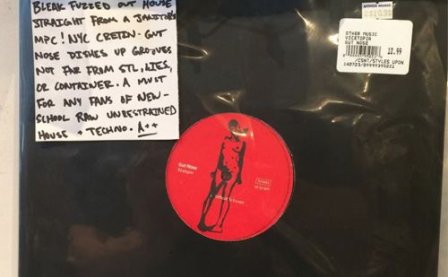Gut Nose is the project of New York-based Andrew Vagabundo, whose last name proves weirdly aptronymic, as he makes meandering yet interconnected music on his first full-length album for Styles Upon Styles. Filthy City is equally split between two formats: Side A, “Filthy City,” is a murky beat tape of hip-hop instrumentals in the style of classic Mo’ Wax or Def Jux boom bap, and Side B, “Filthnoid Mixx,” is a dancefloor-crushing set of hard techno similar to Gut Nose’s “Vicetopia” 12-inch.
Which on its own sounds like a fun album. But what really holds together these near-20-minute tracks are the unnerving aural spaces they explore. Determined to bring his bedroom studio work to a live format, Vagabundo employs an MPC and a number of vintage mixers and devices that blend the rhythms and hooks of Filthy City in a defiantly filthy way, using noise and bizarre effects to augment his turntablism. The transitions between beats on “Filthy City” are mostly sound detritus: cycles of washy vinyl noise, sluggish scratches, and over-processed samples, spun up by Vagabundo and whipped into freakish shapes. This unorthodox approach works as mischief and borders on misanthropy, an aural tour of the filth-city as both tourist destination and unraveled social wasteland.
It turns Side A into a seedy dérive, a night on the town tainted by encroaching toxic discomfort. Vagabundo is a talented collagist, and he knows how to speed up a guitar loop or bitcrush a drum hit in a way that startles you but keeps you excited for what comes next, as with the brusque acceleration on the segment originally known as “Oblique Collusion,” which buckles to an alien chop-and-screw stomp, or in the sparse and tongue-in-cheek sampling of the album’s last few minutes, which pairs a barely-there outro with field recorded MTA subway sounds.
Some of Gut Nose’s pieces sound unconventional and sloppy, but together they evoke drunken playfulness with a vagrant, antagonistic character. While perhaps not intentionally, this idea of a DJ as having an indifference to the decay of their set reminds me of the melancholic beat satiation of Ghettoville. Both have a similar aversion to clarity and a more visceral pleasure principle, throwing out frequencies and trashing samples to fit a mood. It does seem like there is some sort of story taking place on Filthy City, although its exact points I can’t detail. But there is a sense of reaction to the rhythms, of motion and evolution, that works as a corollary to trip-hop.
On Side B, the pounding “Filthnoid Mixx,” Vagabundo treats techno with a morbid curiosity as to its flexibility. The pieces flow together seamlessly on side B, making for a more solidly pleasant experience albeit a more conventional one. It reduces a slew of filthy techno bangers to a squelchy bootleg tape, replete with basement-dancehall acoustics and enough smoggy clouding to make your speakers break out in a sweat, culminating in a final spin-down that mirrors the start of the record. He pushes the compression pretty heavy with whatever old equipment he’s working on, making every hi-hat hiss and every kick drum sound like crushing rocks. It speeds up and phases a little bit, but mostly it climbs and climbs and never lets up, offering listeners a chance to dance themselves clean before everything starts over again.
Filthy City is a good beat tape, wrapped with interesting paper. It isn’t outstanding, though. Some of the loops are pretty unsubstantial and work better at maintaining a coherent flow and a mood than on their own. Treating each side as a single piece (rather than the four or five sketches that comprise the record’s source material) actually does wonders for Gut Nose’s overall album flow. It results in the same kind of quasi-proggy beat staging that Burial essentially hides whole albums in under the guise of song suites. “Filthy City” benefits a lot from not treating the breaks themselves as an end but as staging posts on a longer, headier trip. It is impossible to predict on first listen where each wayward diversion will end up, even if some of them wind up duds. Ultimately, Filthy City works because it offers elusive, smart sequencing and isn’t afraid to incinerate its own flow several times over. A middling beat tape of old breaks would have become an instant pastiche, but Gut Nose’s wanton sonic abuse adds a much needed tinge of malice and paints a more vivid image, trash and all, of a metropolis gone to waste.
More about: Gut Nose




